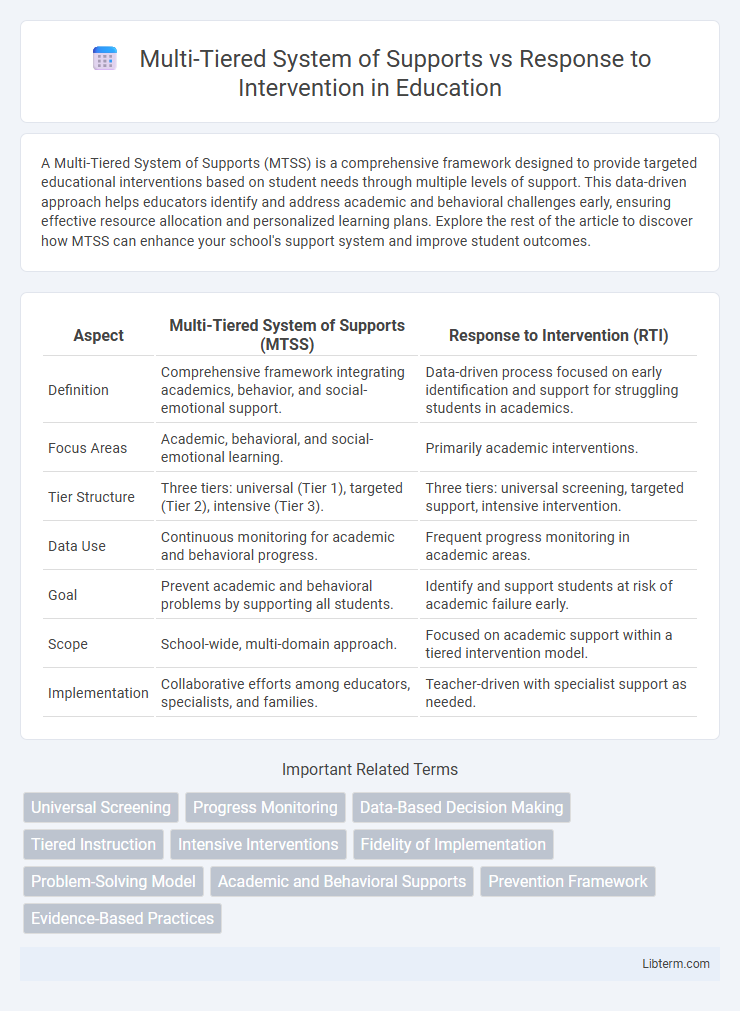A Multi-Tiered System of Supports (MTSS) is a comprehensive framework designed to provide targeted educational interventions based on student needs through multiple levels of support. This data-driven approach helps educators identify and address academic and behavioral challenges early, ensuring effective resource allocation and personalized learning plans. Explore the rest of the article to discover how MTSS can enhance your school's support system and improve student outcomes.
Table of Comparison
| Aspect | Multi-Tiered System of Supports (MTSS) | Response to Intervention (RTI) |
|---|---|---|
| Definition | Comprehensive framework integrating academics, behavior, and social-emotional support. | Data-driven process focused on early identification and support for struggling students in academics. |
| Focus Areas | Academic, behavioral, and social-emotional learning. | Primarily academic interventions. |
| Tier Structure | Three tiers: universal (Tier 1), targeted (Tier 2), intensive (Tier 3). | Three tiers: universal screening, targeted support, intensive intervention. |
| Data Use | Continuous monitoring for academic and behavioral progress. | Frequent progress monitoring in academic areas. |
| Goal | Prevent academic and behavioral problems by supporting all students. | Identify and support students at risk of academic failure early. |
| Scope | School-wide, multi-domain approach. | Focused on academic support within a tiered intervention model. |
| Implementation | Collaborative efforts among educators, specialists, and families. | Teacher-driven with specialist support as needed. |
Understanding Multi-Tiered System of Supports (MTSS)
The Multi-Tiered System of Supports (MTSS) is a comprehensive framework designed to provide targeted academic and behavioral interventions across multiple levels of intensity. MTSS integrates data-driven decision-making to identify students' needs early, ensuring timely support through tiered instruction and progress monitoring. This system promotes collaboration among educators to create a holistic approach that addresses diverse student challenges proactively.
Defining Response to Intervention (RTI)
Response to Intervention (RTI) is a systematic approach to identifying and supporting students with learning and behavioral needs through early intervention and continuous progress monitoring. RTI incorporates multiple tiers of instruction intensity, starting with high-quality classroom teaching and progressing to targeted interventions. This framework emphasizes data-driven decision-making to tailor interventions and prevent academic failure before special education referral.
Core Components of MTSS
The Core Components of the Multi-Tiered System of Supports (MTSS) include universal screening, data-based decision making, and tiered instructional interventions targeting academic, behavioral, and social-emotional needs. MTSS integrates academic and behavioral supports through three tiers of escalating intensity: Tier 1 focuses on high-quality classroom instruction, Tier 2 provides targeted small group interventions, and Tier 3 delivers intensive individualized support. This framework promotes continuous progress monitoring and collaboration among educators to ensure effective interventions based on student responsiveness.
Key Elements of RTI
Response to Intervention (RTI) emphasizes early identification and support for students through a three-tiered model involving universal screening, targeted interventions, and intensive support based on continuous progress monitoring. Key elements of RTI include data-driven decision making, evidence-based instruction, and frequent student assessment to guide instruction adjustments. This framework ensures timely identification of learning difficulties, reducing special education referrals by providing interventions aligned with individual student needs.
MTSS vs RTI: Fundamental Differences
Multi-Tiered System of Supports (MTSS) integrates academic, behavioral, and social-emotional interventions within a comprehensive framework, unlike Response to Intervention (RTI), which primarily targets reading and academic proficiency. MTSS employs a broader data-driven decision-making process, incorporating multiple dimensions of student performance across tiers, while RTI focuses mainly on early identification and targeted instruction for learning disabilities. The fundamental difference lies in MTSS's holistic approach to student success, encompassing universal screenings, progress monitoring, and supports that address diverse needs beyond academics alone.
Overlapping Features of MTSS and RTI
Multi-Tiered System of Supports (MTSS) and Response to Intervention (RTI) both utilize data-driven decision-making and layered levels of educational support to address student needs. They emphasize early identification and intervention through progress monitoring and evidence-based instruction across multiple tiers. Collaboration among educators and integration of academic and behavioral strategies represent core overlapping features that enhance student outcomes.
Benefits of Implementing MTSS
Implementing a Multi-Tiered System of Supports (MTSS) enhances student outcomes by integrating academic, behavioral, and social-emotional interventions within a unified framework, promoting early identification and targeted assistance. MTSS fosters data-driven decision making through continuous progress monitoring, enabling educators to tailor instruction effectively and reduce achievement gaps. This comprehensive approach supports all learners by aligning resources across tiers, thereby increasing efficiency and improving overall educational equity compared to traditional Response to Intervention (RTI) models.
Advantages of RTI in Educational Settings
Response to Intervention (RTI) enhances early identification of learning difficulties by providing targeted, evidence-based interventions at multiple tiers, reducing the need for special education referrals. RTI emphasizes continuous progress monitoring, allowing educators to tailor instruction based on student responsiveness and data-driven insights. This dynamic approach promotes inclusive education by addressing diverse learner needs within the general education environment.
Choosing Between MTSS and RTI: Factors to Consider
Choosing between Multi-Tiered System of Supports (MTSS) and Response to Intervention (RTI) hinges on the scope of educational needs and intervention frameworks; MTSS offers a comprehensive approach addressing academics, behavior, and social-emotional learning, while RTI primarily targets academic interventions. Key factors to consider include the existing school infrastructure, the range of student needs, and the capacity for data-driven decision-making across multiple tiers. Evaluating resource availability, staff training, and alignment with state or district mandates ensures effective implementation tailored to student success and systemic efficiency.
Future Directions in Academic and Behavioral Support Systems
Future directions in academic and behavioral support systems emphasize integrating Multi-Tiered System of Supports (MTSS) with enhanced data-driven decision-making and personalized interventions tailored to diverse student needs. Innovations in technology and real-time progress monitoring are expanding the effectiveness of MTSS frameworks, enabling more precise identification of at-risk students and adaptive support strategies. Emphasis on equity and culturally responsive practices will continue to shape the evolution of MTSS and Response to Intervention (RTI), driving systemic improvements in educational outcomes.
Multi-Tiered System of Supports Infographic

 libterm.com
libterm.com